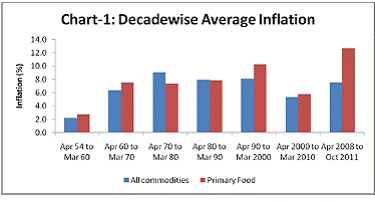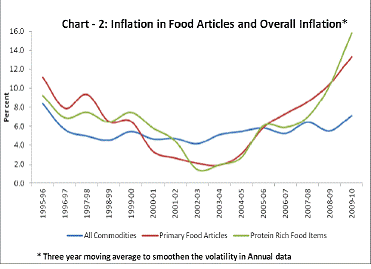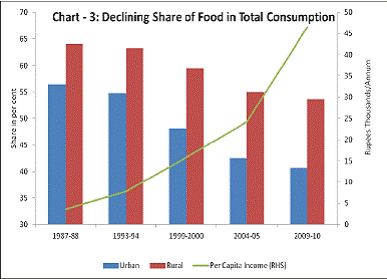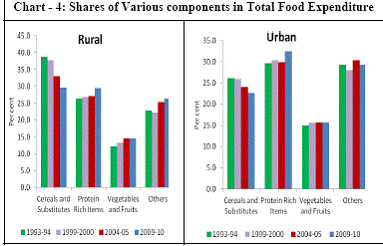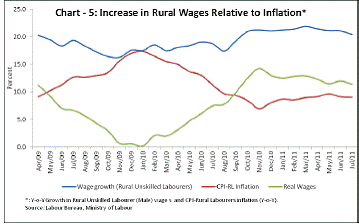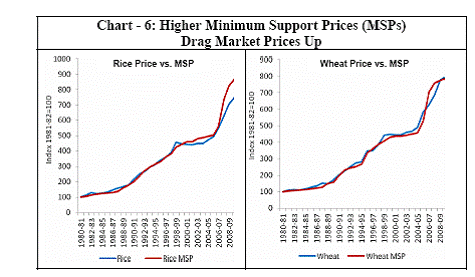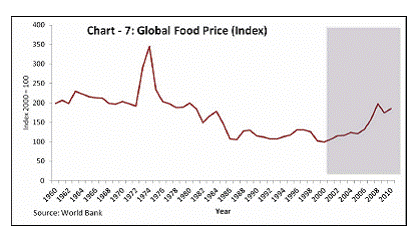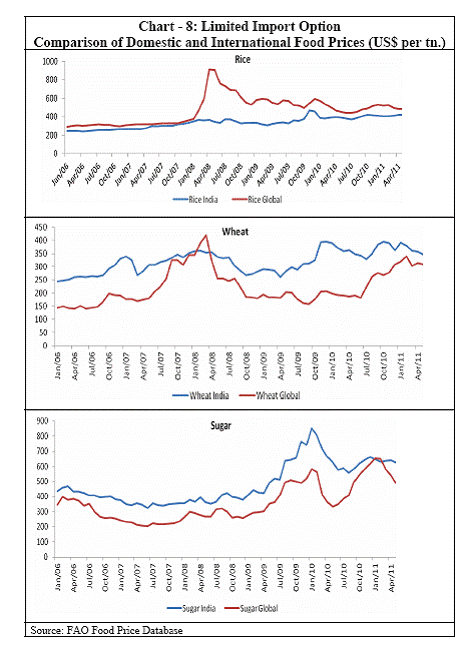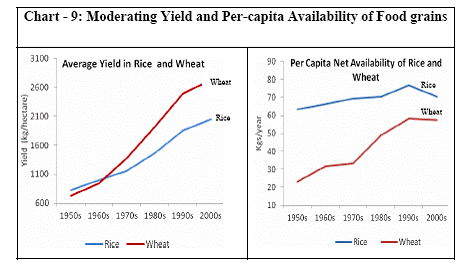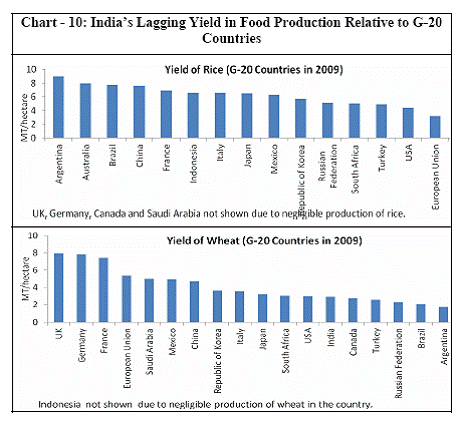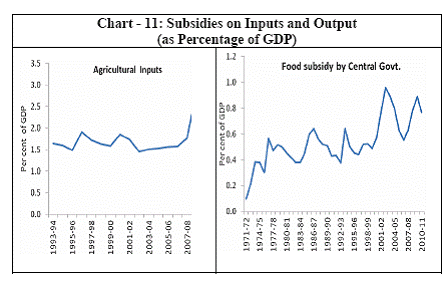 IST,
IST,


The Challenge of Food Inflation
Dr. D. Subbarao, Governor, Reserve Bank of India
Delivered on Nov 22, 2011
First of all, my thanks to the Indian Society of Agricultural Marketing, particularly to Prof. Radhakrishna, the President, and Prof. Satyanarayana, Secretary of the Society for inviting me to address this conference. Speaking to a gathering of distinguished agricultural economists is an opportunity to which I attach a lot of value. Whenever I am invited to speak, I struggle to determine a topic that is relevant to the organizers, and is also within the domain of the Reserve Bank. In this instance though, I did not have any problem since there is a vast subject area that is of mutual interest to the Reserve Bank and to agricultural economists, particularly economists with sub-specialization in agricultural marketing. For today, I have chosen to speak on the challenge of food inflation. I.The Context 2. Persistent and elevated food inflation over the last few years has emerged as a major policy concern, especially as it can potentially threaten our collective aspiration for a ‘higher, inclusive and sustainable’ growth. Intriguingly, we are experiencing high food inflation in the face of record production of food grains, robust buffer stocks and growing resilience of agriculture to monsoon uncertainties. Evidently, the dynamics of food inflation have changed significantly, and understanding them is obviously important for a policy response. 3. A related question that has engaged economists has been the role, if any, of the central bank in combating food inflation. Opinion on this has spanned the entire spectrum. At one end is the view that monetary policy should be the ‘first line of defence’ no matter what the drivers of inflation. At the other end is the view that monetary policy is an inappropriate instrumentality to address supply pressures, and that the central bank should adopt a ‘hands off’ approach. Real world, as we know, is too complex for such binary text book prescriptions; management of food inflation has always been a complex challenge for the Reserve Bank, both by way of policy action and its communication. 4. What I propose to do in this address is to first highlight the trends in food inflation over the past 60 years. Having thus set the context, I will turn to factors driving structural food inflation, which should give us a perspective of the underlying dynamics and the nature of the challenge. I will then move on to indicating the policy measures for addressing the challenge of food inflation on a durable basis. I will, in the end, address an issue more directly relevant to the Reserve Bank – the role of monetary policy in the face of supply shocks. II. Trends in Food Inflation over last Six Decades 5. An assessment of the inflation trends over last six decades indicates that India has encountered successive bouts of high food inflation, but the underlying drivers have changed over time;the influence of monsoon has declined and some new sources of price pressures have emerged. What is particularly notable is that during the 2000s, average food inflation fell significantly [Chart-1].In contrast, since 2008-09 (i.e. about last three and half years), average food inflation has been higherthan the average food inflation in each of the past six decades. This cannot all be attributed to poor monsoon. Sure, rainfall was deficient in 2009, but so was it in 2002 and 2004. But, in the earlier years, food inflation remained modest, at less than three per cent over three successive years during 2002-05 whereas it shot up to double digits in 2009.What has changed in recent years to cause sustained price pressures? This is the big question we need to answer to find a durable solution to food inflation.
III. Factors Driving Food Price Pressures 6. What are the factors driving food inflation? I would emphasize the following: (i) shift in dietary habits towards protein foods; (ii) pressure stemming from inclusive growth policies; (iii) large increases in MSPs of foodgrains; (iv) shocks from global food inflation; and (v) financialisation of commodities. Let me take them up one by one. (i) Shift in Dietary Habits Towards Protein Foods 7. A distinct feature of recent food price inflation has been the sustained price pressure in protein rich items (pulses, milk, fish, meat and eggs). Inflation in protein rich items has generally exceeded both headline (WPI) inflation and inflation in primary food articles [Chart-2]. 8. As one would expect, the share of food in total expenditure has declined over successive rounds of NSSO surveys alongside increases in per capita income, consistent with Engel’s Law [Chart-3].
9. We need to turn to the lesser known Bennet’s Law for an explanation of food inflation. Bennet’s Law suggests that as incomes increase, the proportion of starchy staples in the food basket declines relative to the share of more expensive sources of calories. Recent NSSO data showing a significant increase in the share of protein rich items in total food expenditure, both in rural and urban areas, confirm this hypothesis [Chart-4]. Though protein inflation, reflecting changing dietary habits, was evident earlier as well, the pace of increase has been sharperin recent years reflecting,in part, accelerated increases in nominal wages.
10. Even in the face of such structural changes in dietary habits, inflation is not inevitable. The reason structural changes have triggered inflation in India is that the supply response in respect of most protein items has not been adequate. With the exception of pulses, other protein rich items are not crop products. This is an important point since it explains the growing disconnect between the performance of agriculture and the trajectory of food inflation. (ii) Pressure on Food Inflation Stemming from Inclusive Growth 11. Unlike the growth-inflation tradeoff, the possible tradeoff between inclusive growth and inflation has not received much attention. The need for making growth inclusive is incontestable, but it is important to recognize that policies aimed at inclusion can stoke inflationary pressures, at any rate in the short-term. I could mention two examples here:first, the significant increase in rural wages triggered by the MGNREGS, and second, inflationary implications of the proposed Food Security Bill. 12. The MGNREGS, guaranteeing at least one hundred days of wage employment to rural labour, in implementation since February 2006, has pushed up rural wages, in line with the expected outcomes of the scheme. The indexation of the wage rate to CPI-AL since the beginning of 2011 has exacerbated the wage-price inflation spiral. NSSO survey data (61st Round and 66th Round) suggest that nominal wages of workers, in both rural and urban areas, increased much faster in the second half of the 2000s than in the first half. In most states, wageshave increased faster thanCPI-RL inflation,pushing up real wages [Chart-5].
13. Consistent with the characteristic of a low income country, increase in wages in India has quickly translated to increase in per capita expenditure. Average nominal per capita expenditure increased sharply in the second half of the decade (2005-10) compared to the first half (2000-05), rising from 3.6 per cent per annum to 10.5 per cent in rural areas, and 5.3 per cent per annum to 10.9 per cent in urban areas. The MGNREGS has evidently set the floor for the rural wage level, making wage push inflation more visible and prominent. Admittedly, increase in wages need not be inflationary provided it reflects higher productivity, but that is not currently the case, a point to which I will return later. 14. The National Food Security Bill, 2011 is another potential source of pressure on inflation, and its inflationary impact will depend on the extent to which it will raise demand for food grains relative to the normal increase in supply. The proposed billtargets two categories of households - priority households and general households - under which 75 per cent of the rural population (with at least 46 per cent of the population belonging to priority households) and 50 per cent of the urban population (with at least 28 per cent of the population belonging to priority households) will become entitled to subsidized food grains. The price restrictions are quite exacting and failure by the government to meet the obligations entails payment of a food security allowance to the beneficiary. 15. Estimates suggest that 68 per cent of the country’s 1.2 billion population will get a legal entitlement for food grains after the bill is enacted, significantly raising the annual grain procurement demand even as the available marketed surplus would not increase correspondingly. This will create demand pressures, which will inevitably spillover to market prices of food grains. Furthermore, the higher food subsidy burden on the budget will raise the fiscal deficit, exacerbating macro level inflationary pressures. (iii) Large Increases in MSPs of Food Grains 16. Recent years have witnessed a significant increase in minimum support prices (MSP) of several agricultural commodities, pushing up food inflation. This is particularly evident from the neatly anchored co-movement of market prices and MSPs for rice and wheat [Chart-6]. The Commission for Agricultural Costs and Prices (CACP) has typically followed a cost plus pricing formula for determining the MSP, and in an environment of rising wages and increasing input costs, rising MSPs have accentuated inflation pressures.
17. Compared with the past, hikes in MSPs for wheat and rice have been more substantial in recent years, as the following table shows.
18. Given the cost plus formula for the determination of MSPs, the increase in MSPs as above is consistent with the rising input costs as evidenced by figures below.
19. It is a fair presumption that MGNREGS has considerably affected labour costs while also tightening availability of agricultural labour during peak seasons. Given that Indian agriculture is labour intensive, sustained wage pressures can keep food price inflation high even in years of record food production as was the case in 2010-11. (iv) Shocks from Global Food Inflation 20. Given India’s growing integration with the world economy, global food prices affect our domestic prices even if there is no trade. Global food price pressures have been quite acute in recent years reflecting growing demand and a weak supply response. Demand side pressures have stemmed from growing population and rising incomes. Supply side pressure have been triggered by a host of factors - increasing urbanization, diversion of land for bio-fuel production, inadequate investment in research and technology, spikes in costs of inputs such as diesel and fertilizer and disturbances arising from climate change. The impact of these factors underpinning high food prices was amplified further by country specific policy interventions, particularly export bans on specific commodities by certain countries. Import barriers in some countries to protect domestic producers and large subsidies to farm production in several advanced economies have also influenced the supply response of farm output to distorted price signals. 21. According to an assessment by OECD-FAO, global food inflation situation will remain grim over the next ten years. It is important to note that prices of food items actually declined in real terms over several decades from early 1960s to early 2000 [Chart-7]. This trend began to be reversed, gradually during 2003-06, and rapidly thereafter up until the 2008 global financial crisis. After some moderation in 2009, food prices have again edged up, tending closer to pre-crisis peaks. The OECD-FAO Agricultural Outlook 2011-20 indicates that prices may be higher in real terms over the five years 2015-20, relative to the levels prevailing during the five year period 1998-2003 by 40 per cent in case of rice, 27 per cent for wheat, 48 per cent for maize and 36 per cent for oil seeds. What the above global outlook clearly suggests is that we will not get any comfort from the global situation in managing our food inflation.
22. Even in a situation of low global prices, India does not enjoy the import option given the huge size of our consumption. Global food markets are notoriously thin, and even the mere signal of a large consumer like India entering the market can spike up prices. Moreover, in some commodities such as rice, Indian prices have been lower than global prices [Chart-8] suggesting that even if imports could expand domestic supply, they would not soften inflationary pressures.
(v) Financialisation of Commodities - A New Source of Price Pressure 23. Some analysts contend that speculation in commodity futures has been a key driver of global food inflation in recent years. In general,there has been a marked increase in financial investment in commodity markets, relative to both global GDP and physical commodity production. Do activities in commodity futures market reflect genuine needs of hedging?Does speculation systematically influence the commodity prices and lead to increased price volatility? These are questions that are as yet largely unsettled in academic and policy discussions. At any rate, the financialisation channel is often perceived to have magnified the impact on prices of the disequilibrium between demand and supply, thereby weakening the role of fundamentals in the price formation process. 24. In India, prices of several commodities which are not traded on the commodities exchange, such as fruit and milk, have significantly increased in the recent period. Moreover, certain commodities that were banned for trading in 2007, such as rice, wheat, tur and urad also exhibited price increases subsequently. Even after the ban imposed on trading of sugar in 2009, sugar prices had increased considerably. Evidence of any relationship between futures market activities in commodities and their spot prices is ambiguous. Nonetheless, this needs close monitoring and certainly further research. IV.Addressing the Challenge of Food Inflation 25. Having discussed the sources of food price pressures, let me now turn to how we may respond to the challenge of food inflation. (i) Raise Agricultural Productivity 26. The Green Revolution,entailing adoption of high yielding variety (HYV) seeds in the mid 1960s and the use of the fertilizer-pesticides-irrigation package,resulted in quantum jumps in productivity (i.e. output per acre), especially of rice and wheat. By the early 1980s, productivity across all major crops had peaked, but the momentum had slowed thereafter. Consequently, per-capita availability of food grains, especially of rice and wheat, has started declining [Chart-9]. A comparison of crop yields across G-20 countries shows the extent to which India has lagged behind others [Chart 10].
27. Even our best productivity achievements in terms of yields of major crops are way behind world numbers. During 2010-11, Punjab, with the highest yield in rice, produced 3.8 tonnes per hectare as against the world average of 4.3 tonnes per hectare. Yield of oilseeds in Tamil Nadu, the highest in India, at 2.1 tonnes per hectare is lower than the US average of 2.7 tonnes per hectare. There are wide variations in productivity levels of crops across states. Unlike food grains where the Green Revolution improved the food security situation, we are still not self-sufficient in pulses and edible oilseeds. The demand for other farm products like fruits and vegetables has also been rising significantly faster than supply, putting pressure on food inflation. 28. The growth of agriculture and allied sector was most impressive during the 6th Five Year Plan period (1980 to 1985) when it peaked at 5.8 per cent. The annual average agricultural growth rate moderated thereafter as shown in the following table.
29. How do we respond to declining growth and moderating productivity improvements? The overall policy framework for agriculture, driven primarily by remunerative prices and subsidized provision of inputs, needs to change; the focus would have to shift to productivity and selective policy stimulus to items where the supply response has been weak. Public expenditure needs to reorient towards building capital infrastructure for agriculture which in turn would ‘crowd-in’ private investment and help realize the full potential of agriculture growth. There has been no major technological breakthrough in agriculture since the Green Revolution of the mid-60s. There have been achievements in some specific crops such as cotton, basmati rice and maize, but that needs to be broad based. The Green Revolution also needs to penetrate the eastern region, where the yields have generally remained low. 30. Management of climatic concerns is becoming increasingly important given the continuing dependence on rainfed farming, frequent floodsin eastern India, frost, particularly in north-western India, and heat waves and cyclones on the east coast. These climatic changes are likely to significantly increase volatility in agricultural production. Recent large increases in prices of some items like onion, sugar, vegetables and cotton are, at least in part, a result of seasonal weather related factors, both domestic and external. (ii) Rethink Price Policy Interventions 31. Paradoxically, in India, we subsidize both agricultural inputs and outputs, and we subsidize both producers and consumers. There is a case for revisiting the subsidy regime for a number of reasons, including the pressure it exerts on food inflation. Subsidies on inputs (fertilizer, electricity, irrigation) to incentivize production and subsidies on output for the PDS system, entail a large fiscal burden [Chart-11]. Over and above the input subsidies, remunerative MSPs and procurement for the public distribution system (PDS) at prices linked to MSP further distort the price situation. There is a moral hazard here like in any subsidy. A farming sector that depends excessively on input subsidies and cost plus MSPs to raise production does not have much of an incentive to raise productivity. If the amount spent on subsidies could be diverted to augment capital formation in agriculture and creation of rural infrastructure, higher productivity would raise the income of farmers while lowering the prices for the consumers.
32. MSPs pose a major policy dilemma. Remunerative prices are necessary to engineer the desired supply response, but higher MSPs also lead to higher inflation. A segment of the population could be protected against inflation through the subsidized PDS, but depending on the difference between the PDS price and the MSPs at which procurement is made, and the quantity supplied through PDS, food subsidies could swell. 33. The share of agriculture in GDP has declined significantly (to about 15 %), but a large section of the labour force (about 53 %) still depends on agriculture for its livelihood. If the per-capita income of those who depend on agriculture has to increase, productivity of agriculture has to increase (so that even without higher food prices, per capita income could increase) and the percentage of labour force depending on agriculture has to decline (which would require creation of employment opportunities in non-farm activities). (iii) Improve Supply Chain Management 34. The supply chain through which farm products move to reach the final consumers is a major source of price pressures. Two initiatives, currently under debate, that could potentially improve the situation are: (a) revamping the PDS to check leakage of food subsidies, and (b) allowing entry of FDI into multi-brand retailing. 35. Let us take the PDS first. The Government’s food management policy has been largely driven by two goals: (a) maintaining buffer stocks to deal with food shortages and thereby ensuring food security; and (b) providing food at subsidized prices to the poor through the PDS. The food stocks at any point of time, thus, reflect the end result of additions through procurement and depletions through release for PDS. 36. Management of food stocks is riven by a debate between two opposing points of view. One view is that food stocks should play a market stabilization role such that whenever market prices rise significantly, reflecting particularly supply chain manipulation, stocks should be released into the market to soften prices. The opposing view is that use of food stocks to intervene in the market dilutes the role of competitive market forces, and that the Government should instead focus on easing supply chain rigidities. 37. Given the enormous administrative costs of the PDS and its perceived leakages, several alternatives have been suggested, although none of them is without its specific problems. By far the most straightforward is direct cash transfers, but its implementation is conditional on universal financial inclusion. Besides, since cash is fungible, the objective of distributing food at subsidized prices can potentially be compromised. Distribution of food grains with utilization linked to UID is another option, but that again is conditional on universal UID coverage. In the event of a switch over to cash transfers, the supply chain could become even more important in rural areas, since by manipulating supply and prices, food dealers could extract a share of the cash transferred to the beneficiaries. 38. There are also several proposals on the table for improving supply chain management. Given that protein food inflation stems especially from perishable items such as milk, eggs, meat, fish, vegetables and fruits, the case for a better supply chain management becomes stronger. The most actively discussed option is allowing FDI into multi-brand retail. The Government’s discussion paper on the subject argues that super market-chains could lower costs and increase efficiency because of scale economics. They will also lead to better safety and quality standards. 39. Evidence from cross-country experience on the benefits of multi-brand FDI on inflation is ambiguous. Several questions persist. Will the supermarket chains, focusing as they do on urban consumption centres for scale of economy reasons, leave the rural population behind? Also, if there are such clear scale economies and cost advantages, why aren’t domestic investors jumping in to exploit the potential? 40. Another issue in supply chain management is reform of some restrictive statutes and regulations. Even as production of vegetables and fruits has increased in recent years, around 40 per cent of it goes waste between the farm gate and the market for want of cold chain and transport infrastructure. Implementation of the model Agriculture Produce Marketing Committee (APMC) Act 2003, which provides for direct marketing, contract farming and setting up of markets in private and cooperative sectors is a possible option to address this problem. (iv) Manage Competition for Land From Non-farm Activities 41. Land is the single most important input for agriculture. Besides being a key determinant of socio-economic status, it provides collateral for credit and for security in the event of natural hazard or contingencies. The supply of land, as we know, is fixed. Over the years, there has been a significant change in the pattern of land use. Net sown area, which increased at a rate of 18 per cent during 1951-71, has either declined or remained stagnant since then. Increased cropping intensity over the years, however, has led to an increase in gross cropped area, though at a slowing pace in recent decades. As a result, there has been no significant increase in the share of net cropped area in total geographical area since the 1970s. 42. A notable aspect of the changing land use pattern is that the share of cultivable land not used for agricultural purposes has increased from a low of 2.8 per cent of the total geographical areas in 1950-51 to 7.5 per cent in 2004-05. This may be indicative of increased diversion of agricultural land for non-agricultural purposes, such as urbanization, housing, industrialization, and infrastructure. It is a fair presumption that such diversion would have further gained pace since 2004-05. Land acquisition for industrial and other commercial uses is an issue that has been headline news in recent years; clearly, it is an emotive issue involving difficult tradeoffs. No matter how the tradeoffs are resolved, the reality of increasing demand for land from fast growing and more productive sectors cannot be ignored. The possibility of declining arable land available for cultivation underscores the importance of increasing productivity if we are to contain food inflationary pressures. 43. There are several other problems. First, land holding in India is highly fragmented, with marginal holdings (of one hectare or less) accounting for as high as 62 per cent of all operational holdings. The small farm size in a labour surplus agrarian sector leads to intensive use of land,but in the absence of supporting infrastructure and capacity to access modern technology and inputs, productivity remains low. Second, rainfed agriculture constitutes as much as 55 per cent of the cropped area and 45 per cent of the total agricultural output. More than 70 per cent of pulses and oilseeds production as well as a substantial part of horticulture and animal husbandry produce is from rainfed farming, underscoring significant continuing monsoon dependence. Third, water is going to be as precious as land in the long-run, and costs of irrigation will increase significantly, not only in terms of the actual cost of access to the irrigation facility, but also by way of costs arising from competing demand from non-agriculture sectors for the limited supply of water. Fourth, dry land farming would have to receive greater attention, but there will be greater competition even for dry lands from urbanization and infrastructure. V.Monetary Policy and Inflation 44. Now let me turn to a question that is more directly relevant to the Reserve Bank - what is the role of a central bank in combating food inflation? As I said earlier, the answer to this question spans the entire spectrum. 45. That monetary policy should respond if there is inflation, meaning there is sustained increase in the general price level, is beyond question. But high food prices often result from adverse supply shocks or large increases in input costs. The conventional wisdom is that if inflation expectations are well anchored, monetary policy need not react to supply shocks. This premise is based on the assumption that the supply shocks are purely temporary. This assumption does not always hold. In the real world, oftentimes supply shocks are structural and lead to a permanent trend upward shift in prices. 46. So, the challenge for a central bank is to determine if the supply shock is temporary or permanent. If it is permanent, then the change in relative prices caused by it can result in higher general inflation, in the first round by the higher input costs, and in the second round through the impact on inflation expectation and wage bargaining. In other words, when supply shocks impact the trend or the core component of inflation, monetary policy should respond. 47. The question of responding to a supply shock gets more complex in the context of the growth inflation trade-off. Unlike demand shocks, supply shocks have asymmetric implications for inflation and growth. In the case of a negative demand shock, such as wealth loss caused by say, a crash in asset prices, the impact on output and prices is generally in the same direction. The policy response in such a situation is unambiguous. In the event of a negative supply shock, such as lower farm output resulting from monsoon failure, however, while headline inflation goes up, output may come down. Thus, in the case of a negative supply shock, monetary policy confronts the dilemma of stabilising output versus containing inflation. 48. Oftentimes, this is a delicate balancing act. If the supply shock is transitory, then the preferred policy response could be to accommodate the price pressures, recognizing the limitations of monetary policy in directly dealing with supply induced price pressures. If on the other hand, the supply shock persists, or due to strong demand conditions, the supply shock transmits to other components of general inflation, then monetary policy has to respond. Thus, in case of the former, monetary accommodation prevents further disruption to the growth momentum. In the latter case, however, ant-inflationary monetary response may involve some sacrifice of growth. Conclusion 49. Let me now conclude. The thrust of my address has been to emphasize the several factors that are driving food inflation: (i) shift in dietary habits towards protein foods; (ii) pressure stemming from inclusive growth policies; (iii) large increases in the minimum support prices (MSP) of food grains; (iv) shocks from global food inflation; and (v) financialization of commodities. 50. Inflation is a regressive tax and hurts the poor the most. The impact can be particularly severe in a country like India with a population of 1.2 billion, a per capita income of less than $1500 and a large share of food in the total consumption basket. 51. As discussed earlier, the direct role of monetary policy in combating food price pressures is limited, but in the face of sustained high food inflation, monetary action may still be warranted to anchor inflation expectations. A lasting solution to food price pressures lies in a supply response that raises agricultural production and productivity, improves supply chain management and sets the right incentive framework for both producers and consumers. The outlook on food inflation in the short to medium term will be determined by the speed and quality of such a supply response by the Government. |
|||||||||||||||||||||||||||||||||||||||||||||||||||||||||||






